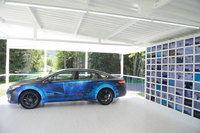Toyota DARV: A smarter car for safer driving

Not so many years ago, there was little in a car to draw the driver’s attention away from the road beyond the windows, mirrors and speedometer. Today, even a regular mid-market car can feature a plethora of displays, controls and meters, all vying for attention and increasing the risk of driver distraction.
Toyota is researching how best to keep the driver focused on the road without sacrificing any of the benefits offered by sophisticated on-board information systems, working with Microsoft and Infosys as its partners in DARV 1.5, the latest generation of Toyota’s Driver Awareness Research Vehicle.
Think of a car that can work like a tablet, recognising you and automatically presenting an information menu on its side window as you approach. Touch and swipe the glass and you are up to speed on your route, your personal schedule, weather conditions and where to stop for more fuel en route, even before you’ve sat behind the wheel. This means that once on your way, there are fewer issues needing your attention other than the road ahead and traffic conditions around you.
These functions were pioneered by Toyota in its original DAR-V, revealed at last year’s Los Angeles motor show. Now it has taken the concept further with DARV 1.5, engineered at the company’s Collaborative Safety Research Center in Ann Arbor and previewed recently at the Aspen Ideas Festival in Colorado.
DARV 1.5 is a fully functioning car that provides a working platform for studying the dynamics of driver distraction. A development of the original MPV-based DAR-V, it is equipped with Microsoft’s Surface tablet and Kinect motion-sensing technologies and custom-designed Infosys biometric software to help everyone on board and the car itself to work together as a team to achieve safer driving.
New features include a driver “lock-in” function that identifies who is at the wheel by tracking their body frame, and automatically enabling or disabling control features according to who using the control panel. Advances have also been made in determining how wearable devices, such as smart watches, might be used to control vehicle functions. As a working car, DARV 1.5 can also measure driver behaviour and produce a “score” based on safe driving choices.
Toyota also used the festival for the US debut of its production-ready Fuel Cell Sedan. Osamu Nagata, President and CEO of Toyota Motor Engineering and Manufacturing North America, said: “Our society is on the cusp of a revolution in personal mobility. Slowly but surely, new technologies are changing how we think about automobiles and transportation, from intelligent automated systems that team up with drivers to improve safety, to zero-emissions vehicles that emit nothing but water vapour.
“These technologies will help save lives, improve the environment, create jobs and help us maintain technical leadership in a field that is an important contributor to economic growth.”

